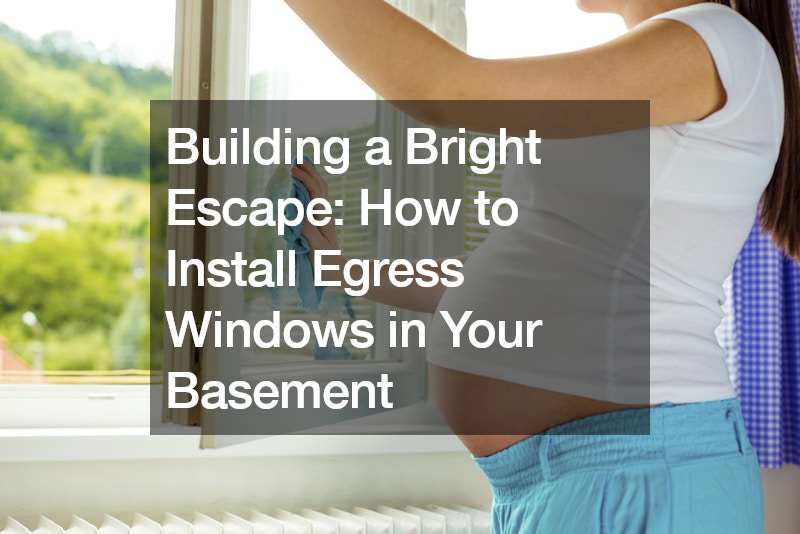
Building a Bright Escape How to Install Egress Windows in Your Basement
Transforming a basement from a dark, underutilized space into a functional and inviting area can significantly enhance your home’s value and livability. One crucial element in achieving this transformation is the installation of egress windows. Egress windows provide an essential safety feature and allow natural light to flood the basement, creating a more cheerful and inviting atmosphere.
This article explores the process of installing egress windows in your basement, outlining the key steps involved and providing valuable tips for a successful project.
The Benefits of Egress Windows:
Egress windows offer a multitude of benefits for your basement:
Safety First: In the unfortunate event of a fire or other emergency, egress windows provide a secondary escape route for occupants trapped in the basement. This additional exit can be critical to ensure a safe and swift evacuation during emergencies.
Natural Light Transformation: Basements are often windowless, leading to a dark and gloomy environment. Egress windows allow natural light to enter the space, brightening the basement and making it feel more welcoming. This improved lighting can significantly enhance the functionality and appeal of the basement.
Increased Value: Homes with finished basements with egress windows tend to command a higher market value. The additional living space, improved safety features, and natural light offered by egress windows are highly sought-after by potential buyers.
Code Compliance: Many local building codes mandate the installation of egress windows in habitable basement spaces. Failing to comply with these codes can hinder future renovations, prevent obtaining permits, and could even impact the resale value of your home.
Planning Your Egress Window Installation:
Before embarking on your egress window installation project, thorough planning is essential. Here are some key considerations:
Local Codes: Familiarize yourself with the specific egress window requirements established by your local building code department. These regulations typically address window size, location, minimum opening dimensions, and well depth.
Permitting: Obtaining the necessary permits is crucial before starting any construction work. Permitting requirements can vary by location, so consulting your local building department is essential.
Professional Consultation: While some homeowners are comfortable tackling DIY egress window installation, seeking professional guidance from a qualified contractor can be beneficial. This can provide valuable planning advice, ensure code compliance, and address unforeseen challenges.
The Egress Window Installation Process:
The installation process can begin Once you’ve completed your planning and obtained the necessary permits. Here’s a breakdown of the key steps:
Excavation: A large hole needs to be dug to create a space for the egress window well. Consider renting an excavator to expedite this process, especially if dealing with a significant amount of earth.
Drainage System: Proper drainage prevents water from accumulating around the window well. This may involve connecting a drain pipe to your existing drainage system as per local regulations.
Window Well Construction: The window well provides a safe and secure enclosure for the egress window. Pressure-treated lumber is commonly used to construct well walls, ensuring long-term durability. Proper leveling and bracing are crucial during this stage.
Window Installation: An opening in the foundation wall is necessary to accommodate the egress window. Diamond blade saws are often used for precise and efficient cutting. The window buck (frame) is installed within the opening, followed by the egress window itself.
Insulation and Finishing Touches: Insulation around the window opening is vital for maintaining a comfortable temperature in the basement. Finally, adding trim around the window and cladding the window’s interior will enhance the space’s aesthetics and functionality.
Safety Considerations for Egress Windows:
Egress windows are designed to serve as emergency exits. Here are some important safety considerations:
Minimum Window Size: Egress windows must be large enough for a safe and easy exit for adults and children. Local building codes will specify the minimum dimensions for width and height.
Clear Opening: The egress window must provide a clear opening large enough for a person to crawl through easily. This means ensuring furniture, plants, or other objects don’t obstruct the opening.
Window Well Escape: The window well should be designed to allow for easy egress. Proper depth is crucial, and steps or a ladder may be necessary depending on the well depth.
Window Well Cover: A secure but easily removable window well cover is essential for safety and debris prevention. Fixed covers can create a safety hazard during an emergency escape.
Building a Brighter Basement Future
Installing egress windows in your basement is an investment in your home’s safety and overall enjoyment. By following these steps, you can install egress windows in your basement, which is an investment in your home’s safety and overall enjoyment. By following these steps and prioritizing safety considerations, you can create a bright escape in your basement, transforming it from a dark, underutilized space into a functional, inviting, and code-compliant area.
Additional Tips for a Successful Egress Window Installation:
Call Before You Dig: Before starting excavation work, contact your local utility locating service to identify and mark any underground utilities in the area. This crucial step prevents accidental damage to electrical lines, gas pipes, or water lines.
Protect Yourself: Wear proper personal protective equipment (PPE) such as gloves, safety glasses, and sturdy footwear during the excavation and construction process.
Work with a Helper: A helper during installation can be extremely beneficial. Tasks like holding the window during installation or assisting with heavy materials become much easier with additional manpower.
Prioritize Quality Materials: Investing in high-quality materials for the window, window well, and drainage system ensures long-term durability and performance.
Weatherproofing: Meticulously seal around the window opening and well to prevent water infiltration and potential basement moisture issues.
Long-Term Maintenance: Regularly inspect the egress window well for debris accumulation and ensure the window operates smoothly for a quick and unobstructed escape route.
Conclusion
Building a bright escape in your basement through egress window installation can significantly enhance your home’s functionality, livability, and resale value. While the process requires careful planning, prioritizing safety, and potentially professional guidance, the rewards are substantial. A well-lit, safe, and inviting basement space adds square footage to your home and provides peace of mind, knowing you have a secondary escape route in case of emergencies. Following these guidelines and prioritizing a safe and well-executed installation, you can transform your basement into a bright and valuable part of your living space.
.




